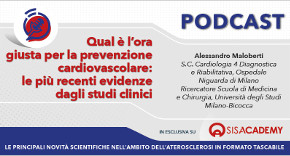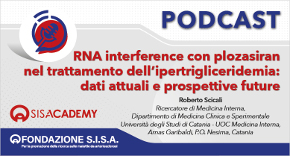 Rivista in lingua italiana
Rivista in lingua italiana
riservata ai Soci SISA
Ultimo numero:
Anno 16 • N.1/2025
Abstract
Nonoptimal lipids commonly present in young adults and coronary calcium later in life: the CARDIA (Coronary Artery Risk Development in Young Adults) study
Pletcher MJ, Bibbins-Domingo K, Liu K, Sidney S, Lin F, Vittinghoff E, Hulley SB.
Ann Intern Med 2010;153:137-46
BACKGROUND: Dyslipidemia causes coronary heart disease in middle-aged and elderly adults, but the consequences of lipid exposure during young adulthood are unclear.
OBJECTIVE: To assess whether nonoptimal lipid levels during young adulthood cause atherosclerotic changes that persist into middle age.
DESIGN: Prospective cohort study.
SETTING: 4 cities in the United States.
PARTICIPANTS: 3258 participants from the 5115 black and white men and women recruited at age 18 to 30 years in 1985 to 1986 for the CARDIA (Coronary Artery Risk Development in Young Adults) study.
MEASUREMENTS: Low-density lipoprotein (LDL) and high-density lipoprotein (HDL) cholesterol, triglycerides, and coronary calcium. Time-averaged cumulative exposures to lipids between age 20 and 35 years were estimated by using repeated serum lipid measurements over 20 years in the CARDIA study; these measurements were then related to coronary calcium scores assessed later in life (45 years [SD, 4]).
RESULTS: 2824 participants (87%) had nonoptimal levels of LDL cholesterol (>or=2.59 mmol/L [>or=100 mg/dL]), HDL cholesterol (<1.55 mmol/L [<60 mg/dL]), or triglycerides (>or=1.70 mmol/L [>or=150 mg/dL]) during young adulthood. Coronary calcium prevalence 2 decades later was 8% in participants who maintained optimal LDL levels (<1.81 mmol/L [<70 mg/dL]), and 44% in participants with LDL cholesterol levels of 4.14 mmol/L (160 mg/dL) or greater (P < 0.001). The association was similar across race and sex and strongly graded, with odds ratios for coronary calcium of 1.5 (95% CI, 0.7 to 3.3) for LDL cholesterol levels of 1.81 to 2.56 mmol/L (70 to 99 mg/dL), 2.4 (CI, 1.1 to 5.3) for levels of 2.59 to 3.34 mmol/L (100 to 129 mg/dL), 3.3 (CI, 1.3 to 7.8) for levels of 3.37 to 4.12 mmol/L (130 to 159 mg/dL), and 5.6 (CI, 2.0 to 16) for levels of 4.14 mmol/L (160 mg/dL) or greater, compared with levels less than 1.81 mmol/L (<70 mg/dL), after adjustment for lipid exposure after age 35 years and other coronary risk factors. Both LDL and HDL cholesterol levels were independently associated with coronary calcium after participants who were receiving lipid-lowering medications or had clinically abnormal lipid levels were excluded.
LIMITATION: Coronary calcium, although a strong predictor of future coronary heart disease, is not a clinical outcome.
CONCLUSION: Nonoptimal levels of LDL and HDL cholesterol during young adulthood are independently associated with coronary atherosclerosis 2 decades later.
PRIMARY FUNDING SOURCE: National Heart, Lung, and Blood Institute.
Ann Intern Med 2010;153:137-46

Area Soci
Eventi
39° Congresso Nazionale
 39° Congresso Nazionale
39° Congresso NazionaleRoma, 23-25 novembre 2025
Save the date




 Spring Meeting Gruppi Giovani SID, SIGG, SIIA, SIMI, SIPREC, SISA
Spring Meeting Gruppi Giovani SID, SIGG, SIIA, SIMI, SIPREC, SISARimini, 6-8 aprile 2025
[continua a leggere]
 SISA LIPID ACADEMY - Corso avanzato di lipidologia clinica
SISA LIPID ACADEMY - Corso avanzato di lipidologia clinicaModena, 4-5 Luglio 2024
[continua a leggere]Giornale Italiano Arteriosclerosi
HoFH today
 Rivista Italiana della
Rivista Italiana della
Ipercolesterolemia
Familiare Omozigote
Anno 6 • N.1/2024
Rivista NMCD
Diateca
[continua a leggere]
[continua a leggere]
Newsletter
il vostro indirizzo di posta elettronica
Progetto LIPIGEN

Nuovo sito dedicato al Progetto LIPIGEN
Progetto LIPIGEN - Vecchio portale
E' necessario essere loggati come utente
Lipigen per poter accedere alla pagina
PROject Statin Intolerance SISA
PROSISA – PROject Statin Intolerance SISA
E' necessario essere loggati come utente
PROSISA per poter accedere alla pagina
GILA - Lipoprotein Aferesi
Gruppo Interdisciplinare Lipoprotein Aferesi
(Accesso Gruppo GILA-Lipoprotein Aferesi)
E' necessario essere loggati come utente del Gruppo GILA per poter accedere
Gruppo Interdisciplinare Lipoprotein Aferesi
(Documentazione ad accesso libero)
Pagina informativa per medici e pazienti










